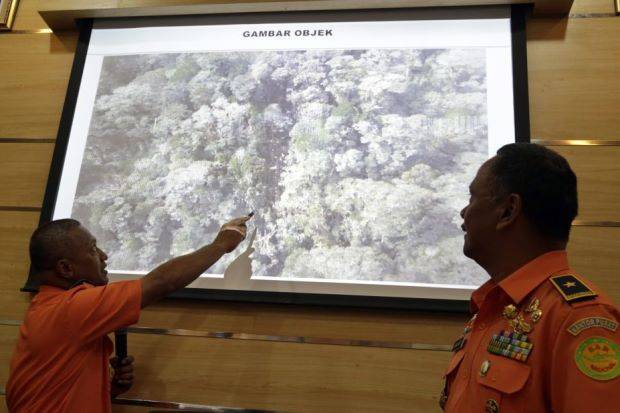Treacherous terrain in Indonesia's Papua province on Monday hampered rescuers' efforts to reach a passenger plane that crashed with 54 aboard, the latest in a string of aviation disasters in the sprawling Southeast Asian archipelago.
Rescuers have yet to detect the aircraft's black boxes and news of survivors depends on a ground team now trekking slowly towards the mountainous area, the rescue official overseeing the search said.
"If it collided into a mountain, there has never been a case of survivors. But who knows, let's wait," said Major-General Heronimus Guru, operations director at Indonesia's National Search and Rescue Agency.
Rescue teams arriving at the site will have to build a helipad to fly in help, Guru told a news conference in the Indonesian capital, adding that 266 people were involved in the operation, while 11 aircraft scoured the thickly forested area.
As dusk falls in Papua, search operations will resume at 6.30 a.m. on Tuesday, depending on the weather.
Guru displayed grainy photographs of what is believed to be the site of Sunday's crash of the Trigana Air Service ATR 42-300 plane, in the heavily forested Bintang Mountains district.
Officials of Trigana, placed on the European Union's list of banned carriers since 2007 over safety or regulatory concerns, were not immediately available to respond to questions from Reuters.
There were 44 adult passengers, five children and infants and five crew on the short-haul flight from Sentani Airport in Jayapura, capital of the province of Papua, south to Oksibil.
All aboard were Indonesian nationals, officials have said.
Earlier reports have said the aircraft was carrying cash of about $470,000 destined for remote villages, as part of an official assistance program.
Poor infrastructure in Indonesia's easternmost province means that assistance money is often flown in by air, said post office spokesman Abu Sofjan.
There was no suggestion the large sum of money carried on the plane was linked to the crash.
Guru told reporters the cash was not a priority and confirmation of the cause of the crash would have to await an official investigation by a national transport safety panel.
"I feel that it collided into a mountain, but let's wait for the KNKT," he said, referring to the panel by its official name, the National Transportation Safety Commmittee.
Erratic weather could have played a role in the crash, said another official.
"It's the weather there, it changes all the time. In the morning it can be clear and hot, and then suddenly it rains," said Sito, a communications operator with the rescue agency in Jayapura.
A Super Puma helicopter crashed in the same area last year, said Sito, who goes by one name, like many Indonesians.
The crashed ATR 42-300 made its first flight 27 years ago, the Aviation Safety Network says. Trigana Air Service has a fleet of 14 aircraft, aged 26.6 years on average, the airfleets.com database says.
Trigana has had 14 serious incidents since it began operations in 1991, online database Aviation Safety Network says. Besides the latest crash, it has written off 10 aircraft.
Indonesia has a patchy aviation safety record, with two major plane crashes in the past year.
One involved an AirAsia flight that went down in the Java Sea, killing all 162 aboard. In June, more than 100 people died in the crash of a military transport plane, prompting Indonesia's president to promise a review of the ageing air force fleet.






